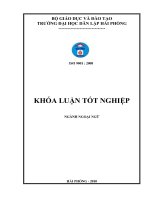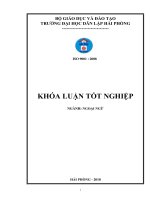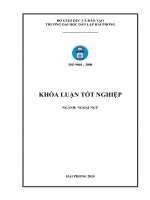A study on english acronnym in the name of international organizations
Bạn đang xem bản rút gọn của tài liệu. Xem và tải ngay bản đầy đủ của tài liệu tại đây (490.6 KB, 56 trang )
BỘ GIÁO DỤC VÀ ĐÀO TẠO
TRƯỜNG ĐẠI HỌC DÂN LẬP HẢI PHỊNG
------------------------------\\\\
ISO 9001 : 2008
\\
KHĨA LUẬN TỐT NGHIỆP
NGÀNH: NGOẠI NGỮ
HẢI PHÒNG - 2010
HAIPHONG PRIVATE UNIVESITY
FOREIGN LANGUAGES DEPARTMENT
-----------------------------------
GRADUATION PAPER
A STUDY ON ENGLISH ACRONYM IN THE NAMES
OF INTERNATIONAL ORGANIZATIONS
By:
Vũ Thị Ngọc Anh
Class:
Na1001
Supervisor:
Mai Văn Sao, M.A
HAI PHONG - 2010
BỘ GIÁO DỤC VÀ ĐÀO TẠO
TRƯỜNG ĐẠI HỌC DÂN LẬP HẢI PHÒNG
--------------------------------------
Nhiệm vụ đề tài tốt nghiệp
Sinh viên: ............................................................Mã số:............................
Lớp: .............................Ngành:....................................................................
Tên đề tài: .................................................................................................
..................................................................................................
.................................................................................................
..................................................................................................
Nhiệm vụ đề tài
1. Nội dung và các yêu cầu cần giải quyết trong nhiệm vụ đề tài tốt
nghiệp ( về lý luận, thực tiễn, các số liệu cần tính toán và các bản vẽ).
……………………………………………………………………………..
……………………………………………………………………………..
……………………………………………………………………………..
……………………………………………………………………………..
……………………………………………………………………………..
……………………………………………………………………………..
2. Các số liệu cần thiết để thiết kế, tính tốn.
……………………………………………………………………………..
……………………………………………………………………………..
……………………………………………………………………………..
……………………………………………………………………………..
……………………………………………………………………………..
……………………………………………………………………………..
……………………………………………………………………………..
3. Địa điểm thực tập tốt nghiệp.
……………………………………………………………………………..
……………………………………………………………………………..
……………………………………………………………………………..
CÁN BỘ HƯỚNG DẪN ĐỀ TÀI
Người hướng dẫn thứ nhất:
Họ và tên:.............................................................................................
Học hàm, học vị:...................................................................................
Cơ quan công tác:.................................................................................
Nội dung hướng dẫn:............................................................................
Người hướng dẫn thứ hai:
Họ và tên:.............................................................................................
Học hàm, học vị:...................................................................................
Cơ quan công tác:.................................................................................
Nội dung hướng dẫn:............................................................................
Đề tài tốt nghiệp được giao ngày 12 tháng 04 năm 2010
Yêu cầu phải hoàn thành xong trước ngày 10 tháng 07 năm 2010
Đã nhận nhiệm vụ ĐTTN
Đã giao nhiệm vụ ĐTTN
Người hướng dẫn
Sinh viên
Hải Phòng, ngày tháng năm 2010
HIỆU TRƯỞNG
GS.TS.NGƯT Trần Hữu Nghị
PHẦN NHẬN XÉT TÓM TẮT CỦA CÁN BỘ HƯỚNG DẪN
1. Tinh thần thái độ của sinh viên trong quá trình làm đề tài tốt
nghiệp:
……………………………………………………………………………..
……………………………………………………………………………..
……………………………………………………………………………..
……………………………………………………………………………..
……………………………………………………………………………..
……………………………………………………………………………..
……………………………………………………………………………..
……………………………………………………………………………..
2. Đánh giá chất lượng của khóa luận (so với nội dung yêu cầu đã đề ra
trong nhiệm vụ Đ.T. T.N trên các mặt lý luận, thực tiễn, tính tốn số
liệu…):
……………………………………………………………………………..
……………………………………………………………………………..
……………………………………………………………………………..
……………………………………………………………………………..
……………………………………………………………………………..
……………………………………………………………………………..
……………………………………………………………………………..
………………………………………………………………………
3. Cho điểm của cán bộ hướng dẫn (ghi bằng cả số và chữ):
……………………………………………………………………………..
……………………………………………………………………………..
……………………………………………………………………………….
Hải Phòng, ngày ….. tháng ..… năm 2010
Cán bộ hướng dẫn
(họ tên và chữ ký)
NHẬN XÉT ĐÁNH GIÁ
CỦA NGƯỜI CHẤM PHẢN BIỆN ĐỀ TÀI TỐT NGHIỆP
1. Đánh giá chất lượng đề tài tốt nghiệp về các mặt thu thập và phân tích tài
liệu, số liệu ban đầu, giá trị lí luận và thực tiễn của đề tài.
2. Cho điểm của người chấm phản biện :
(Điểm ghi bằng số và chữ)
Ngày.......... tháng......... năm 2010
Người chấm phản biện
Acknowledgements
In the process of completing this graduation paper, I have received a
great deal of help, guidance and encouragement from many teachers and
friends.
First of all, I would like to express my deepest thanks to my
supervisor, Mr. Mai Van Sao M.A who has given me suggestions on how to
shape the study always been most willing and ready to give me valuable
advice, helpful comments as well as correction of my graduation paper.
Next, I would like to express my gratitude to other teachers in Foreign
Language Department for their previous lectures and instructions during four
years which help me much in completing this study.
Finally, I would like to thank my family and my friends who have
always encouraged, supported and helped me to complete this study.
Haiphong, June 2010
Student
Vu Thi Ngoc Anh
Table of contents
Acknowledgement
Part I: Introduction.
1. Reasons of the study................................................................................. 1
2. Scope of the study. .................................................................................. 1
3. Method of the study. ................................................................................ 2
4. Design of the study................................................................................... 2
Part II: Development. ................................................................................. 4
Chapter 1: Theoretical background. ........................................................... 4
1. Introducing acronyms. ............................................................................ 4
2. Definition of the acronym. ...................................................................... 5
3. Classification of the acronym. ................................................................ 6
A. Monograms based on the letter in one design......................................... 6
B. Homonymy- based on acronyms. .......................................................... 7
4. Rules of writing the acronym. ................................................................. 7
A. Some general rules of writing the acronym. ........................................... 7
B. Some specific cases of writing the acronym. .......................................... 9
Chapter 2: Names of international organizations. ...................................... 13
I. Names of international organizations stand for in different majors. ........ 13
1. Names of Military Organization. ............................................................. 13
2. Names of Economic Organization ........................................................... 14
3. Names of Environmental Organization.................................................... 19
4. Names of Agricultural Organization. ....................................................... 21
5. Names of Educational Organization. ....................................................... 22
6. Names of Health Organization. ................................................................ 25
7. Names of Funds........................................................................................ 27
8. Names of United Union systems. ............................................................. 28
II. Names of International are used widely in Vietnam as mother tongue. . 30
Chapter 3: Finding and Implication .......................................................... 32
I. Finding ..................................................................................................... 32
II. Some suggestions to study acronym words............................................. 33
III. How to spell and pronounce the acronym.............................................. 34
IV. Some mistakes when using acronym words and solution to fix it. ....... 37
V. Suggestion for further study. ................................................................... 40
Part III: Conclusion. ................................................................................... 42
References .................................................................................................... 44
Part I: Introduction
1. Reasons of the study
Nowadays, learning a foreign language is one of great importance,
especially English. To learn English is not an easy job. One of the problems
that learners of English face with is how to master acronyms. Some of main
reasons can be summarized as follow:
The first, everyday more and more acronyms appear, while old ones
are becoming faded. Not few acronyms are used widely as mother tongue. No
sooner had we learnt to prefer to the Common Market as the EC rather than
the EEC, then it became the EU.
The second, one problem with acronym that is pronounceable as a word
when meet a new one in print, but it may be not known which way to
pronounce correctly. This is a problem now that all acronyms tend to be
written without full stops. A full stop after each letter usually means that the
acronym is pronounced as a string of letters.
The third, an acronym word does not realize surely, misunderstanding
and confusion are therefore unavoidable.
All the mentioned reasons explain the decision of choosing the thesis
“Acronym in the name of international organizations” to study, and it is
expected to provide English learners with much more helpful information
about acronyms.
2. Scope of the study:
When studying a foreign language, learners tend to study grammatical
structures and only focus on the meaning of new words in isolation without
paying much attention to the acronyms.
There are many issues of linguistic semantics, however, due to the
limitation of time and knowledge, this paper only focus on the acronym names of the international organization. All the rest are to be left for further
1
research. Although the best trying have been carried out the study but this
paper cannot provide a summary of all acronyms. The understanding of the
acronym in terms of definitions as well as types will be expressed in details.
Finally, names of popular organizations which are acronyms will be given
out.
In daily conversation, it is recognized that people use many acronyms.
If they are not realized, people cannot understand what they mean. And this
paper is aimed at studying some typical factors to solve difficulties facing the
learners of English vocabulary.
3. Method of the study:
With a view to helping Vietnamese learners of English enlarge their
vocabulary and gain a general understanding of the acronym, the study
generalizes and gives out many different notions and information about the
acronym as much as possible.
All notions and information are generalized and analyzed from many
kinds of documents. Also, the origins of acronym, present the acronym of
organizations will be explained. All the illustrated examples are quoted from
vocabulary books, linguistic books, dictionaries and internet source.
Moreover, this study is also based on the personal experience in life and the
knowledge that have been improved at university.
4. Design of the study:
This study consists of three parts, of which the second is the most
important.
Part I is the introduction which states the reasons of the study, the
scope of the study, the method of the study and the design of the study.
Part II- development is the main content that includes three chapters.
The first chapter provides a theoretical background. It focuses on some
general definitions, types, rules in writing the acronym. The second chapter,
names of international organizations will be investigated. In the last chapter 2
Implication, some suggestions when using acronym are presented. Besides,
some mistakes, misunderstandings of the acronym in daily life will be given
out and how to solve it.
Part III is the conclusion of the whole study which is summarized the
matter discussed in part II.
3
Part II: Development
Chapter I: Theoretical background
I/ An introduction of the acronym
Nowadays, acronyms became a part of ours life. Acronyms are used
widely in every aspect such as: reading, speaking, writing, listening,
communication, etc...
Any shortened form of a word is an abbreviation, for example, "etc."
for "etcetera" and "Oct." for "October;" but acronyms are special kinds of
abbreviations that can be pronounced as words, such as "NASA" (National
Aeronautics and Space Administration) and "OPEC" (Organization of the
Petroleum Exporting Countries). This makes acronyms a subset of
abbreviations. All acronyms are abbreviations, but not all abbreviations are
acronyms.
Most people need an explanation as to what an acronym stands for.
Thus the first time an organization is introduced in a piece of writing, the
accepted practice is to write it out in full and insert the acronym in brackets
after the full name.
e.g., North Atlantic Treaty Organization (NATO)
Marine Corps Development and Education Command (MCDEC)
Asia- Pacific Economic Cooperation (APEC)
Atlantic Free Trade Area (AFTA)
However, if the name of the organization is again used at the start of
the next sentence or near enough to name written out in full for the connection
between them to be made by the reader, there seems no need to put the
acronym in bracket after the full name. There is, of course, no need to give the
4
acronym at all if the organization is only mentioned once in the piece of
writing.
The only exception general allowed to this “ introduced rule” is where
an acronym is so well-known that it is used in common speech more often
than the full name, e.g., the CIA, FBI, BBC and VOA. These and similar
well-known acronym can be used the first time the organization to which they
refer is mentioned in a piece of writing.
II/ Definitions of the acronym
Acronyms are abbreviations, which are formed using the initial letters
of words or word parts in a phrase or name:
+ BBC = British Broadcasting Corporation.
+ UNO = United Nations Organization
+ UNESCO= United Nations Educational, Scientific and Cultural
Organization.
+ ASAP = as soon as possible
+ BTW = by the way
- Some acronyms are existing words taken over as more easily used
alternatives to full forms for example:
+ AIDS stands for Acquired Immune Deficiency Syndrome.
+ WASP from White Anglo- Saxon Protestant.
+ ASEM stands for Asia- Europe Meeting.
+ B.A: Bachelor of Arts.
+ I.Q: Intelligence quotient.
- Some organizations deliberately choose terms for products, projects, or
equipment so that the initials will make an existing name.
+ An example of this is LCD, from Liquid Crystal Display. This is a
kind of screen used on TV or computer, laptop…
+ ATM: automatic teller machine, a kind of machine from which
allowed to withdrawal the cash.
5
+ CPU= Central processing unit.
- There short and friendly - sounding name suggest something pleasant
and accessible. It is used commonly in speaking, writing on message and
internet like:
+ Numbers: 2= to/ two; 4= for/ four; 8 = ate / eight
+ Letters: U = you; C = see; B= be.
+ Texts: LOL = lots of love / laugh out loud; newayz = anyways; lata =
later [bye]; gtg = gotta go; noe = know; TTYL = talk to you later; ss = so
sorry; wan2tlk = want to talk; tc = take care; np = no problem; sul = see you
later; cya = see ya= see you again; j/k = just kidding; bbl = be back later;
etc…
- Campaigning organizations, in particular, choose names to yield an
acronym that is suggestive of their aims.
+ ASH stand for Action on Smoking and Health, wants people to stop
smoking.
+ GASP is the Group Against Smog Pollution.
+ SCUM is the Society for Cutting Up Men, wants to attract your
attention.
III/ Classification of the acronym
It is interesting to include here two special cases of acronyms:
Monograms and Homonyms - based acronyms.
1. Monograms:
A monogram is a motif made by overlapping or combining two or more
letters or other graphemes to form one symbol or one design. Monograms are
often made by combining the initials of an individual or a company, used as
recognizable symbols or logos. A series of uncombined initials is properly
referred to as a cipher and is not a monogram. They are usually used in handkerchiefs, note-paper and in wedding invitations cards.
6
Monograms have been used as signatures by artists and craftsmen on
paintings, sculptures and pieces of furniture. Some companies and
organizations adopt a monogram for a logo, usually with the letters of their
acronym. For example, as well as having an official seal, and the Texas
Longhorns logo, the University of Texas at Austin uses a "UT" monogram (in
the same color as the Longhorns logo, burnt orange).
- There are some pictures to illustrate of monograms:
Ỉ
2. Homonyms:
Homonyms- based acronyms are based on the use of identical sounds
of words and letters.
These words are usually used in common speaking, letter, magazine,
paper, television, and internet, especially, in email and chatting.
e.g., I.O.U - I owe you
G9
- Good night
B4
- Before
O.I.C - Oh I see
N
- And
CU29 - See you tonight
TMR
- Tomorrow
10Q
- Thank you
IV/ Rules of writing the acronym
Acronyms are shortened forms of words or short words made up of
group of letters. Their purposes have provided readily understandable
7
substitutes for clusters of words and aid the reading effort. However, to the
confusion of readers, there are few acronyms whose form has been
standardized internationally.
A. Some general rules of writing the acronym
- The first time using an acronym, it should be used the full name and
the acronym in brackets, e.g.: "According to a report of the United Nations
Environment Program (UNEP), the levels of..." Later in the text, people can
assume the acronym to be known and only use the acronym. If it only returns
in the text much further, author may even want to remind the reader of the full
name.
- To identify them as acronym, most writers will insert a period after
the acronym of a word and after each letter that represents words in a phrase.
But again, there are many exceptions; for example, the United States can be
abbreviates as U.S or US.
- A capitalized letter is often used to present each word in a phrase (the
only exceptions being the articles: and, on, of, the). For example, the radio
broadcast station Voice of America‟s name is abbreviated as either V.O.A or
VOA.
- Originally intended to facilitate the shorthand transcription of
conversation onto paper, when an abbreviation becomes commonly used in
conversations, it may be considered as an acronym.
- Acronyms that are commonly used in English do not have to be
introduced. For example: e.g., BBC, km. For a technical audience, people can
assume that acronyms of commonly used technical measures are understood,
such as ppm and ppb, but rather include the explanation (parts per million,
parts per billion) in case of doubt.
- Names of organizations or policy plans can be long and cumbersome
in text and conversation. Thus, people tend to abbreviate them to save space
or time. However, acronyms create a jargon that can be hard to understand for
8
outsiders. Good and clear academic writing assumes a reader who has a
general academic training, but lacks specialized knowledge of the topic of
writing. As a result, need to be careful with acronyms, even if they have
become very familiar to people.
- Names of Organizations are most often written as a string of capital
letters without full stops, but practice is variable, and Unesco may be seen
U.N.E.S.C.O as well as UNESCO.
- If it is addressed a non-specialist audience, try to reduce the number
of acronyms in a text to the minimum. For example, organization names that
only use once will not have to be abbreviated. If it is used twice, perhaps
people can avoid the second one with "this organization" or some other
reference. In many cases, over-enthusiastic writers include acronyms that are
not essential for the analysis. These can be referred to footnotes or even left
out altogether.
B. Some specific cases of writing the acronym.
1. Lower case acronyms:
Learners read by moving their eyes from right to left across a line of
letters which are broken up into groups called words. Lower case letters are
preferable because they are quicker and easier to read and do not interrupt the
word- flow by making the eyes move up and down. Therefore, as a general
rule, capitals should not be used unless there is a good reason to do, e.g., to
show the beginning of a sentence.
Thus, measures such as „kg‟, „km‟ and „kph‟ are nearly always in
lower case. When they preceded by a figure, the modern practice is not to put
a space between the figure and the acronym, e.g., 0pm, 20lb, 80 kph, 50mph,
and so on.
2. Common phrases:
By common consensus, acronyms of common phrase, such as „i.e.‟ for
„that is‟, are also in lower case.
9
In modern written English, there are no points (periods or full stops)
between the letters (are used to be the case) because these are considered
redundant as they do not add to the recognizing of the acronyms. All readers
instinctively understand what „i.e‟, „e.g‟, „viz‟ and „etc‟ stand for.
However, these acronyms are nearly always followed by a comma
(which represents the natural pause when saying these phrases out loud),
though the comma could be considered as a fragment.
3. Capitalizing acronyms:
In most other cases acronyms are nearly always capitalized even
where they refer to phrases or groups of related words that do not take initial
capitals because they consist of common nouns, such as CAP stands for
Common Agricultural Policy, GDP stands for Gross Domestic Product.
The purpose of this capitalization is to make the acronym more
recognizable as such which, in these cases, outweighs the need to keep the
flow of words as smooth as possible.
The plural of these acronyms is always indicated by a lower case‟s,
e.g., IOUs. Acronyms that are combinations of several words, each of which
is abbreviated to more than one letter, are a mixture of capital and lower case
letters. These mainly occur in academic titles. Each element of the combined
acronym begins with a capital letter and lower case is used for the other letters
as in, for example, PhysD, BComm, and BEng.
4. Names of persons:
There also seems to be no need for the points or periods between the
initials of a person‟s name, which can nowadays be considered totally
redundant.
„P.D.Kennedy‟, for example, is just as understandable as „PD
Kennedy‟ and is also perhaps quicker to read.
However, when the initial of a person are contained in a firm‟s official
name, it would be respectful to follow what that organization does when it
10









